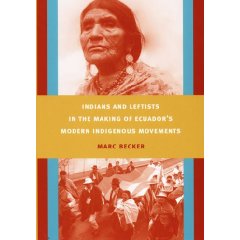
| The Book |
| Chronology |
| Acronyms |
| Glossary |
| Biographies |
| Revolts |
| Documents |
| Data |
This is an Electronic Appendix of documents to accompany my book Indians and Leftists in the Making of Ecuador’s Modern Indigenous Movements (Duke University Press, 2008).

Bulletin of Latin American Research 29, no. 3 (July 2010): 400-402
John Cameron
Dalhousie University, Canada
Becker, M. ( 2008 ) Indians and Leftists in the Making of Ecuador's Modern Indigenous Movements , Duke University Press ( ), xxv + 303 pp. £50.00 hbk, £12.99 pbk.
Marc Becker's Indians and Leftists in the Making of Ecuador's Modern Indigenous Movements challenges the prevailing understandings of the twentieth century history of Ecuador's Indigenous movement in two fundamental ways and offers a loud methodological wake-up call to all social scientists who look to the past in order to understand the present.
Since Ecuador's 1990 Indigenous uprising, numerous social scientists have analysed the rise of a national Indigenous social movement, frequently interpreting it as a triumph of ethnic over class identities and demands. The prevailing understanding of the rise of an explicitly ethnic political agenda in the 1980s has broadly been interpreted as a response to the failure of leftist organisations to effectively mobilise rural Indigenous communities around class-based identities and demands.
Challenging the prevailing understandings of the history of leftist involvement in Indigenous struggles in Ecuador, Becker argues that the 1970s and 1980s represented a low point in the history of the urban left's involvement in Indigenous and peasant communities and does not accurately represent the earlier history of left-based rural organising in the 1920s to 1950s, especially that of the Communist Party and the Federation of Ecuadorian Indians (FEI). As he argues, to interpret the entire history of the leftist involvement in rural struggles from the vantage point of the 1980s is 'a faulty reading of history' (p. 10). By contrast, Becker demonstrates through careful analysis of archival documents that both the Communist Party and the FEI were highly sensitive to ethnic issues and identities and that the relationship between urban communists and rural Indigenous leaders was far more collaborative and respectful than contemporary analysts have recognised.
In this respect, Becker's analysis is important because of its methodological implications for any social scientists who attempt to make sense out of the present through reference to the past. Becker reminds us that history is socially constructed and shaped by the ways in which past events have been recorded and remembered. In the specific context of Ecuador, he draws attention to the ways in which the leading newspapers and government records from the first half of the twentieth century reflected an elite urban bias against Indigenous peasants that considered them to be incapable of political agency and accorded much more influence to urban leftists in rural political struggles than they often deserved. As Becker explains, 'Racial stereotypes led the press to stress the actions of urban leftists, while making the actions of the Indigenous activists invisible. A lasting legacy of the press reports is a warped understanding of the role of communists in Ecuador's modern Indigenous movements' (p. 58). Becker argues that the combination of excessive reliance on newspaper archives and the assumption that the behaviour of the FEI and Communist Party in the 1970s reflected their entire histories have clouded contemporary understandings of the historical relationships between urban leftists and rural Indigenous communities.
The second fundamental challenge that Indians and Leftists poses to prevailing understandings of Ecuador's Indigenous movement concerns the role of women. While press reports and government records highlight interactions with Indigenous men, Becker demonstrates through a more careful reading of those records that Indigenous women were both key leaders and important rank and file participants in the Indigenous struggles of the twentieth century 'commonly pressing their husbands to become more involved' (p. 61). Again, Becker reminds us that 'it is in the writing of history that women disappear into the shadows of male heroes' (p. 8, emphasis in original). Perhaps the only shortcoming of this book is that Becker does not further explore the apparent contradiction between the significant role that women allegedly played in Indigenous struggles in the early to mid twentieth century and the widespread marginalisation of Indigenous women from political decision making by the late twentieth century, with the exception of a few prominent female Indigenous leaders. In a few sentences near the end of the book, Becker does assert that as a result of the increased integration of Indigenous peoples into the dominant society over the course of the twentieth century, the distinct traditions of gender complementarity and Indigenous women's roles in decision-making within their communities were weakened. However, given the emphasis that Becker places on the roles of Indigenous women in political struggles in the early twentieth century, further analysis of the changes in Indigenous women's roles in decision-making and political struggles would have strengthened the book. Nevertheless, Indians and Leftists is an important book that not only challenges prevailing understandings of Ecuador's Indigenous movement, but also provides important methodological insights for those who rely on written history to make sense out of contemporary politics.